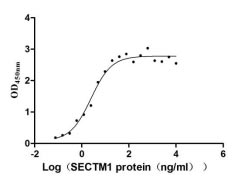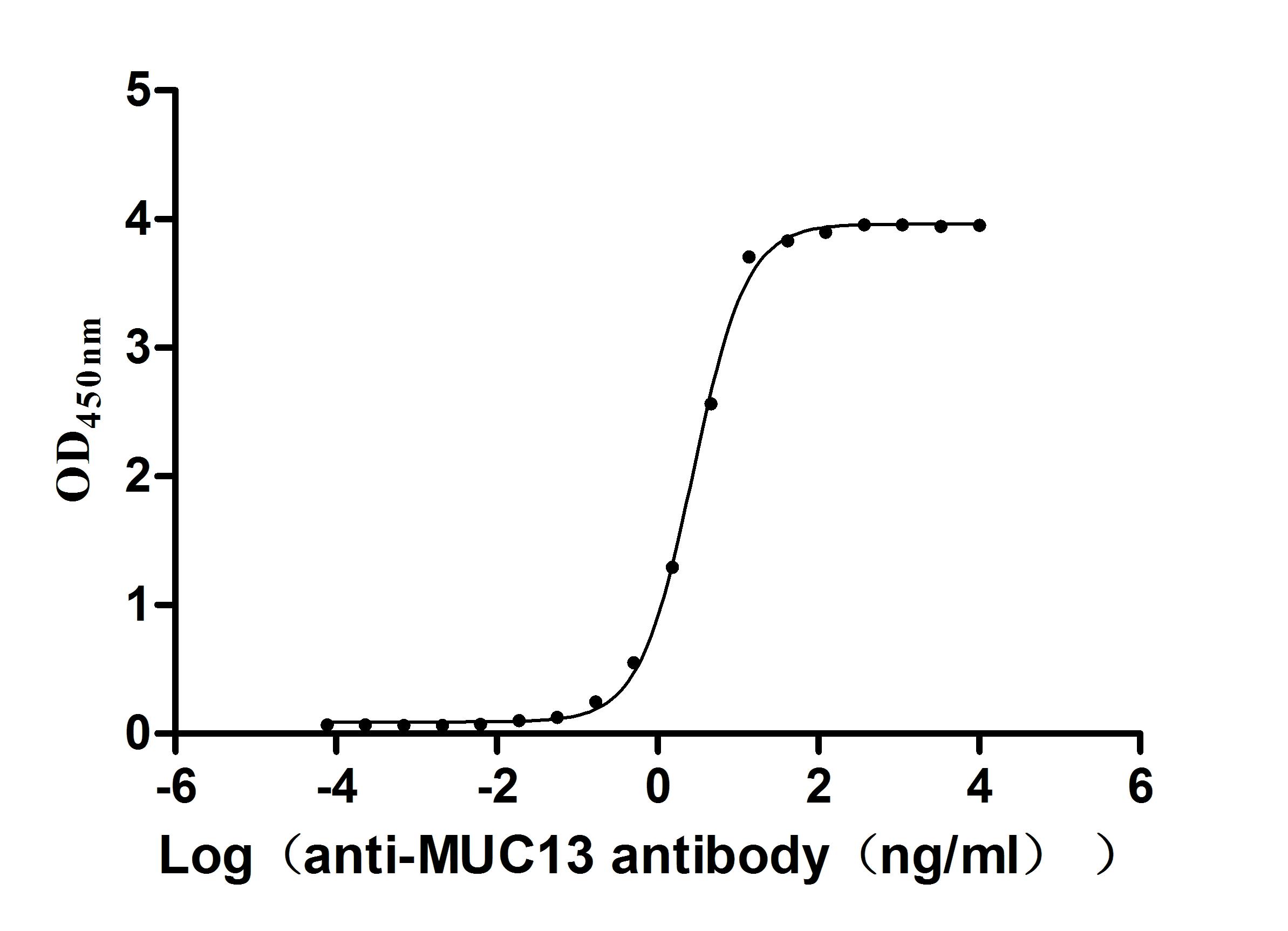Recombinant Human Tumor protein p53-inducible nuclear protein 1 (TP53INP1)
-
中文名称:人TP53INP1重组蛋白
-
货号:CSB-YP822174HU
-
规格:
-
来源:Yeast
-
其他:
-
中文名称:人TP53INP1重组蛋白
-
货号:CSB-EP822174HU
-
规格:
-
来源:E.coli
-
其他:
-
中文名称:人TP53INP1重组蛋白
-
货号:CSB-EP822174HU-B
-
规格:
-
来源:E.coli
-
共轭:Avi-tag Biotinylated
E. coli biotin ligase (BirA) is highly specific in covalently attaching biotin to the 15 amino acid AviTag peptide. This recombinant protein was biotinylated in vivo by AviTag-BirA technology, which method is BriA catalyzes amide linkage between the biotin and the specific lysine of the AviTag.
-
其他:
-
中文名称:人TP53INP1重组蛋白
-
货号:CSB-BP822174HU
-
规格:
-
来源:Baculovirus
-
其他:
-
中文名称:人TP53INP1重组蛋白
-
货号:CSB-MP822174HU
-
规格:
-
来源:Mammalian cell
-
其他:
产品详情
-
纯度:>85% (SDS-PAGE)
-
基因名:TP53INP1
-
Uniprot No.:
-
别名:DKFZp434M1317; FLJ22139; p53 damage inducible nuclear protein 1; p53 dependent damage inducible nuclear protein 1; p53 inducible nuclear protein 1; p53 inducible p53DINP1; p53-dependent damage-inducible nuclear protein 1; p53DINP1; SIP; Stress induced protein; Stress-induced protein; T53I1_HUMAN; Teap; TP53 DINP1; TP53 INP1; TP53DINP1; TP53INP1; TP53INP1A; TP53INP1B; Tumor protein p53 inducible nuclear protein 1; Tumor protein p53-inducible nuclear protein 1
-
种属:Homo sapiens (Human)
-
蛋白长度:full length protein
-
表达区域:1-240
-
氨基酸序列MFQRLNKMFV GEVSSSSNQE PEFNEKEDDE WILVDFIDTC TGFSAEEEEE EEDISEESPT EHPSVFSCLP ASLECLADTS DSCFLQFESC PMEESWFITP PPCFTAGGLT TIKVETSPME NLLIEHPSMS VYAVHNSCPG LSEATRGTDE LHSPSSPRVE AQNEMGQHIH CYVAALAAHT TFLEQPKSFR PSQWIKEHSE RQPLNRNSLR RQNLTRDCHP RQVKHNGWVV HQPCPRQYNY
-
蛋白标签:Tag type will be determined during the manufacturing process.
The tag type will be determined during production process. If you have specified tag type, please tell us and we will develop the specified tag preferentially. -
产品提供形式:Lyophilized powder
Note: We will preferentially ship the format that we have in stock, however, if you have any special requirement for the format, please remark your requirement when placing the order, we will prepare according to your demand. -
复溶:We recommend that this vial be briefly centrifuged prior to opening to bring the contents to the bottom. Please reconstitute protein in deionized sterile water to a concentration of 0.1-1.0 mg/mL.We recommend to add 5-50% of glycerol (final concentration) and aliquot for long-term storage at -20℃/-80℃. Our default final concentration of glycerol is 50%. Customers could use it as reference.
-
储存条件:Store at -20°C/-80°C upon receipt, aliquoting is necessary for mutiple use. Avoid repeated freeze-thaw cycles.
-
保质期:The shelf life is related to many factors, storage state, buffer ingredients, storage temperature and the stability of the protein itself.
Generally, the shelf life of liquid form is 6 months at -20°C/-80°C. The shelf life of lyophilized form is 12 months at -20°C/-80°C. -
货期:Delivery time may differ from different purchasing way or location, please kindly consult your local distributors for specific delivery time.Note: All of our proteins are default shipped with normal blue ice packs, if you request to ship with dry ice, please communicate with us in advance and extra fees will be charged.
-
注意事项:Repeated freezing and thawing is not recommended. Store working aliquots at 4°C for up to one week.
-
Datasheet :Please contact us to get it.
相关产品
靶点详情
-
功能:Antiproliferative and proapoptotic protein involved in cell stress response which acts as a dual regulator of transcription and autophagy. Acts as a positive regulator of autophagy. In response to cellular stress or activation of autophagy, relocates to autophagosomes where it interacts with autophagosome-associated proteins GABARAP, GABARAPL1/L2, MAP1LC3A/B/C and regulates autophagy. Acts as an antioxidant and plays a major role in p53/TP53-driven oxidative stress response. Possesses both a p53/TP53-independent intracellular reactive oxygen species (ROS) regulatory function and a p53/TP53-dependent transcription regulatory function. Positively regulates p53/TP53 and p73/TP73 and stimulates their capacity to induce apoptosis and regulate cell cycle. In response to double-strand DNA breaks, promotes p53/TP53 phosphorylation on 'Ser-46' and subsequent apoptosis. Acts as a tumor suppressor by inducing cell death by an autophagy and caspase-dependent mechanism. Can reduce cell migration by regulating the expression of SPARC.
-
基因功能参考文献:
- Upregulated miR-200a enhances treatment resistance via antagonizing TP53INP1 and YAP1 in breast cancer. PMID: 29329575
- these results revealed that TP53INP1 is a target gene of miR-504 and that miR-504 enhances osteosarcoma growth and promotes distant metastases by targeting TP53INP1. Thus, miR-504/TP53INP1 may be associated with osteosarcoma size and clinical stage. PMID: 29048685
- Low TP53INP1 expression is associated with Metastasis of Hepatocellular Carcinoma. PMID: 28674078
- Negative TP53INP1 protein levels correlated with a poor outcome in pediatric ependymoma. Direct binding of miR-124-3p to its target TP53INP1 is demonstrated. PMID: 28437838
- Results showed that TP53INP1 and E-cadherin mRNA and protein were significantly down-regulated in glioma tumors and positively correlated with higher grade and poor survival. Also, the study provides evidence that TP53INP1 3'-UTR could inhibit the epithelial-mesenchymal transition, thus hindering the migration and invasion of glioma via acting as a competitive endogenous RNA for E-cadherin. PMID: 27341836
- miR-205/TP53INP1 mediated autophagy pathway might be an important molecular mechanism regulating radiosensitivity of prostate cancer cells PMID: 26813458
- silencing of TP53inp1 leads radiation induced autophagy impairment and induces accumulation of damaged mitochondria in primary human fibroblasts. PMID: 26512655
- MicroRNA205 promotes the tumorigenesis of nasopharyngeal carcinoma through targeting TP53INP1 protein. PMID: 26252115
- FOXP1, TP53INP1, TNFAIP3, and TUSC2 were identified as miR-19a targets. PMID: 26367773
- GWAS identifies TP53INP1 as new susceptibility gene for Alzheimer's disease. PMID: 24922517
- TP53INP1 SUMOylation is essential for the regulation of p53 activity induced by oxidative stress. PMID: 24608790
- TGFB1 induced miR-155 regulates TP53INP1 expression, epithelial-mesenchymal transition and acquisition of a stem cell phenotype. PMID: 25633840
- miR-155 may play an important role in promoting the generation of stem cell-like cells and their self-renewal by targeting the gene TP53INP1. PMID: 25601564
- Results demonstrate that miR-569 is overexpressed in a subset of ovarian and breast cancers and alters cell survival and proliferation through downregulation of TP53INP1 expression. PMID: 25490449
- Study reveals that miR-155 acts as an oncogene by targeting TP53INP1 in esophageal squamous cell carcinoma. PMID: 24551280
- Expression of miR-155 is significantly higher in MCF-7 cells compared with MDA-MB-231 cells. Ectopic expression of TP53INP1 inhibits growth of MCF-7 cells by inducing cell apoptosis and inhibiting cell cycle progression. PMID: 24152184
- miR-182/TP53INP1 signaling represents a novel pathway regulating chemoresistance in cisplatin-treated hepatocellular carcinoma PMID: 24447717
- Upregulation of miR-155, mediated by estradiol, and consequent downregulation of TP53INP1 potentially promotes breast cancer development and progression. PMID: 23568502
- Fndings indicate that miR-17-5p/20a promote gastric cancer cell proliferation and inhibit cell apoptosis via post-transcriptional modulation of p21 and TP53INP1. PMID: 23333058
- miR-17-5p functions as a tumor suppressor in cervical cancer cells by targeting tumor protein p53-induced nuclear protein 1. PMID: 22730212
- TP53INP1 antisense oligonucleotide inhibits proliferation and induces apoptosis in castration-sensitive LNCaP tumor cells. PMID: 22213058
- TP53INP1 identified two conserved regions in the DOR family that concentrate multiple functions crucial for autophagy and transcription. PMID: 22470510
- In normal prostate tissues, TP53INP1 is only expressed in prostate basal cells. There is a de novo TP53INP1 expression in prostate luminal cells in inflammatory prostate tissues, high grade PIN lesions and in prostate cancer. PMID: 21538421
- This novel TP53INP1 activity on the regulation of SPARC expression could explain in part its tumor suppressor function in pancreatic adenocarcinoma by modulating cellular spreading during the metastatic process PMID: 21339733
- TP53INP1 is a tumor suppressor in esophageal squamous cell carcinoma (ESCC0; c-Myc-mediated DNA methylation-associated silencing of TP53INP1 contributed to the pathogenesis of human ESCC. PMID: 21219856
- Data show that induction of the stress-induced proteins (SIPs) SIP18 and SIP27, in human- and mouse-derived cell lines, is absent from cells with deleted, mutated or inactive p53, suggesting that regulation of SIP gene expression is dependent on p53. PMID: 12067065
- Assignment of tumor protein p53 induced nuclear protein 1 (TP53INP1) gene to human chromosome band 8q22 by in situ hybridization. PMID: 12438758
- TP53INP1s and HIPK2 could be partners in regulating p53 activity. PMID: 12851404
- TP53INP1s are functionally associated with p73 to regulate cell cycle progression and apoptosis. PMID: 16044147
- TP53INP1 protein negativity is significantly associated with aggressive pathological phenotypes of gastric cancer. PMID: 16521180
- TP531NP1 plays a significant role in the progression of anaplastic carcinoma or contributes to anaplastic transformation from papillary or follicular carcinoma, which is in sharp contrast to findings in previous in vitro and in vivo studies. PMID: 17393983
- PLZF upregulates apoptosis-inducer TP53INP1, ID1, and ID3 genes, and downregulates the apoptosis-inhibitor TERT gene PMID: 17537403
- The p53DINP1 mRna expression in the antral mucosa was significantly lower in the gastric cancer patients than in the chronic gastritis patients. PMID: 18277906
- P53DINP1 mRNA expression promotes Ser46 phophlrylation of p53, without finding a significant correlation between mRNA expression of p53AIP1. PMID: 18277909
- findings implicate a miR-93/miR-130b-TP53INP1 axis that affects the proliferation and survival of HTLV-1-infected/transformed cells PMID: 18974142
显示更多
收起更多
-
亚细胞定位:Cytoplasm, cytosol. Nucleus. Nucleus, PML body. Cytoplasmic vesicle, autophagosome. Note=Shuttles between the nucleus and the cytoplasm, depending on cellular stress conditions, and re-localizes to autophagosomes on autophagy activation.
-
组织特异性:Ubiquitously expressed.
-
数据库链接:
HGNC: 18022
OMIM: 606185
KEGG: hsa:94241
STRING: 9606.ENSP00000344215
UniGene: Hs.492261
Most popular with customers
-
Recombinant Human Secreted and transmembrane protein 1 (SECTM1), partial (Active)
Express system: Mammalian cell
Species: Homo sapiens (Human)
-
Recombinant Human Serine/threonine-protein kinase receptor R3 (ACVRL1), partial (Active)
Express system: Baculovirus
Species: Homo sapiens (Human)
-
Recombinant Human Myosin regulatory light chain 12B(MYL12B) (Active)
Express system: E.coli
Species: Homo sapiens (Human)
-
Recombinant Human B- and T-lymphocyte attenuator(BTLA), partial (Active)
Express system: Mammalian cell
Species: Homo sapiens (Human)
-
Express system: Mammalian cell
Species: Homo sapiens (Human)
-
Recombinant Human Mucin-13(MUC13),partial (Active)
Express system: yeast
Species: Homo sapiens (Human)


















